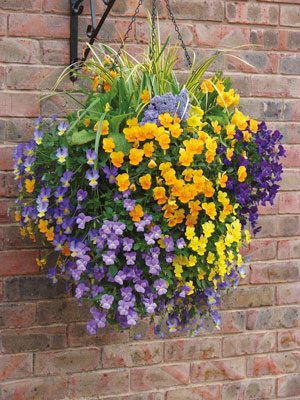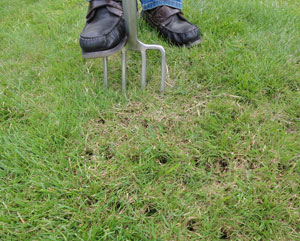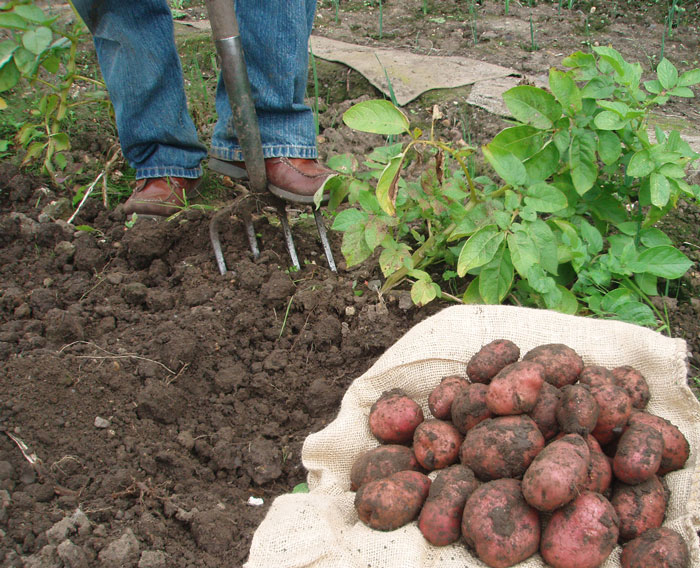September Garden Diary
Our August gardening diary is brought to you by Geoff Hodge of The Scotts Miracle-Gro Company – Lovethegarden.com
As we move into autumn, temperatures start to drop and things start to slow down in the garden – but there’s still plenty to be getting on with. Weather-wise, there’s always the chance of the first autumn frost, so keep an eye out and be prepared to protect tender plants to keep them growing. Severe downpours are also possible, but conversely there is also the possibility of lovely sunny weather – even an Indian summer heat wave! Keep an eye on the weather and be prepared to water your plants wherever necessary in dry conditions.
FLOWER BEDS & BORDERS
 For months of colour from winter to late spring, you can’t beat spring-flowering bulbs. Planting now will reap rich rewards next year – and for many years to come. September is the main planting month, but you can still plant in October and even November if you don’t get round to it now. It is often recommended to leave planting tulip bulbs until November, but this advice is now seen as unnecessary.
For months of colour from winter to late spring, you can’t beat spring-flowering bulbs. Planting now will reap rich rewards next year – and for many years to come. September is the main planting month, but you can still plant in October and even November if you don’t get round to it now. It is often recommended to leave planting tulip bulbs until November, but this advice is now seen as unnecessary.
There are lots of different bulbs to choose from, as well as the popular daffodils and tulips, including Chionodoxa (glory of the snow), Crocus, Galanthus (snowdrops), Ipheion, Muscari (grape hyacinths) and Scilla. It’s also a good time to plant lily bulbs for a riot of summer colour.
Always buy top quality, top grade bulbs as they come with their flower buds in place and are guaranteed to flower in their first year – small, cheap bulbs may not.
As these bulbs will give you many years of pleasure, it pays to improve the soil thoroughly before planting. Dig in plenty of organic matter, such as well-rotted manure, compost, planting compost or bulb fibre, and add bonemeal or a controlled-release plant feed to help improve root growth and establishment. Mix in more organic matter with the soil dug out from the planting hole.
If your summer bedding is starting to look scrappy and going over, remove it and replace with winter- and spring-flowering bedding, such as winter-flowering pansies, violas, polyanthus and primulas, wallflowers, sweet William and bellis daisies.
It is important to plant these sooner rather than later to give them time to establish before the colder weather arrives. The bigger the plants by the end of autumn – the better they’ll perform. Again, it pays dividends to improve the soil with lots of organic matter and a root building plant food at planting time.
Some autumn-flowering plants, especially golden rod (Solidago), Michaelmas daisies (Aster) and Phlox, may be attacked by powdery mildew disease at this time of year. If you see the first signs of the telltale symptoms, spray plants with a systemic fungicide. Keep an eye on other susceptible plants, including clematis, roses and verbena.
Topical tip
Cut back the flowering stems of perennials that are fading and dying down. Those that produce attractive seed heads can be kept for winter interest; the seeds are also useful food sources for birds.
PATIO GARDENING
 Don’t be fooled by autumn showers. No matter how much rainfall your garden receives, your patio pots, planters and hanging baskets may still need to be watered regularly. Always aim to keep the compost evenly moist – not bone dry, then waterlogged. Regular feeding with a high potash liquid plant food will help your plants to continue flowering until the first severe frosts.
Don’t be fooled by autumn showers. No matter how much rainfall your garden receives, your patio pots, planters and hanging baskets may still need to be watered regularly. Always aim to keep the compost evenly moist – not bone dry, then waterlogged. Regular feeding with a high potash liquid plant food will help your plants to continue flowering until the first severe frosts.
Once your summer plants are past their best, replant containers with winter heathers, trailing ivies, dwarf evergreen shrubs and spring-flowering bedding plants to ensure great displays through winter and spring. Remember to replenish the compost with fresh and add a controlled-release feed to keep the plants growing and flowering well.
Topical tip
Don’t forget that most spring-flowering bulbs look fantastic when grown in pots and other containers – including dwarf varieties in hanging baskets. It’s easy to pop in a few bulbs when planting up containers for some extra spring flower power!
LAWNS
The autumn is a big time for lawn care, in order to get it back into tip-top shape after the summer, and to get it ready for the onslaught of winter weather and the spring ahead.
The jobs you’ll need to get on with, in order, are:
• Clear away fallen leaves
• Kill moss
• Rake & scarify
• Aerate
• Top dress
• Feed
For full details on lawn care and the jobs you need to do, visit LoveTheGarden.com
 A summer of heavy use, scalping the grass with a mower set too low and killing weeds and moss can all lead to dead patches and bare areas on the lawn.
A summer of heavy use, scalping the grass with a mower set too low and killing weeds and moss can all lead to dead patches and bare areas on the lawn.
This is a great time to reseed and repair these areas with new grass seed or a lawn patching kit.
Topical tip
If you intend to sow a new lawn this autumn, prepare the area now, ready to sow the seed later in the month or in October.
Dig out all perennial weeds first, add compost or lawn soil and rake flat. Allow the soil to consolidate for two to three weeks, to allow weed seeds to germinate and then clear these away before sowing the grass seed.
GROW YOUR OWN
Vegetables
Although the main vegetable seed sowing season has now passed, there’s still time to sow overwintering turnip, spinach, Oriental vegetables and overwintering onions. In colder regions or for a quicker harvest, sow seeds in pots or cell trays of seed sowing compost in a cold greenhouse or cold frame and grow on and plant out the young plants.You can plant overwintering onion sets to provide an early crop next year.
Continue to feed tomatoes still in crop with a liquid tomato food – as the days shorten, this liquid feed can be invaluable in helping ripen the last fruits of the season. This high potassium plant food will also speed up the ripening of sweet peppers, chillies and aubergines.
Maincrop potatoes should be ready to harvest when the top growth starts to die down and has turned brown. Cut off the dead stem and then leave for 10 days before starting to dig up the tubers. Leave them on the surface for a couple of hours or so for the skins to set and then sort according to their storage potential. Perfect tubers can be placed in hessian sacks, paper bags or dry cardboard boxes for storage in a well-ventilated frost-free shed. Any potatoes that show damage, blemishes or slug or wireworm holes should be used in the kitchen as soon as possible.
Topical tip
Sow some winter lettuce, such as ‘Winter Density’, that can be grown outdoors with some protection from severe weather, or Salad Bowl types, non-hearting, cut-and-come-again varieties that can even be grown in pots on the kitchen windowsill.
Fruit
Now’s the perfect time to order and plant all new fruit trees, bushes and canes. The soil will still be quite warm, and the roots will benefit from this warmth. This is particularly important for peaches and nectarines. Other fruit trees may have a higher tolerance of cold at the roots, and can be planted later in autumn if necessary.
Make sure the soil is well prepared with plenty of organic matter, so dig in plenty of organic matter, such as well-rotted manure, garden compost or tree and shrub planting compost, and add bonemeal or a controlled-release plant food to help improve root growth and establishment. Always plant at the same depth that the plant was originally growing and firm the soil around the roots. Fruit trees will need to be staked with a good tree stake and secured with two tree ties. After planting, give the plants a good soaking to settle the soil and roots and to ensure fast establishment. Mulch the soil with a 7.5-10cm (3-4in) thick layer of bark or similar material, which will help retain moisture around the roots as well as keeping weeds away.
Regularly pick all fruit as it becomes ready. Don’t leave it on the tree or bush to become over-ripe but, at the same time, don’t pick too early or the full flavour won’t have developed. Most fruit is ready when it comes away easily in the hand. Apples and pears are generally ready to pick when they readily part from the tree when lifted gently in the palm and given a slight twist. Pears are best picked when slightly immature. They should then be left a couple of days at room temperature to reach full maturity. Eat bruised and damaged fruit first.
Topical tip
Cut out the old, fruited canes of summer raspberries, blackberries and hybrid berries after fruiting and tie in new ones that will fruit next year. Cut out and remove excess, weak or misplaced canes.
TREES, SHRUBS, ROSES & CLIMBERS
 This is also the perfect time to plant all manner of new trees, shrubs, climbers, roses and hedges. Follow the planting instructions above for fruit. Roses may be showing signs of powdery mildew, blackspot or rose rust. At this time of the year it’s a good idea to pick off all the leaves that are showing disease and dispose of them in the dustbin rather than on the compost heap. Before the end of September spray with a systemic fungicide, and remember to start spraying your roses next year as soon as the first signs of these disfiguring diseases are seen and repeat regularly to keep them at bay.
This is also the perfect time to plant all manner of new trees, shrubs, climbers, roses and hedges. Follow the planting instructions above for fruit. Roses may be showing signs of powdery mildew, blackspot or rose rust. At this time of the year it’s a good idea to pick off all the leaves that are showing disease and dispose of them in the dustbin rather than on the compost heap. Before the end of September spray with a systemic fungicide, and remember to start spraying your roses next year as soon as the first signs of these disfiguring diseases are seen and repeat regularly to keep them at bay.
Topical tip
Shrubs normally pruned hard in the spring – such as buddleia and lavatera – can also be cut back by up to half now, to prevent wind rock and neaten their appearance.
GENERAL GARDENING JOBS
September is an ideal time to kill weeds, especially deep-rooted ones that can’t be dug out easily or grow so big that it would take too much effort to make it worthwhile. For deep-rooted weeds, such as docks, stinging nettles, bindweed, thistles, brambles, couch grass and perennial ryegrass, check out the advice on lovethegarden.com
Japanese knotweed is a garden weed nightmare – in some areas its presence in gardens is preventing affected properties from being sold, because it’s so difficult to control effectively. You can find out more about this pernicious weed and how to deal with it on lovethegarden.com
Topical tip
Now’s a good time to install water butts and water-collection systems to make the most of all the autumn and winter rain. If you already have water butts, give them a good cleaning out to help keep the water fresh.
HOUSEPLANTS
Move houseplants that have been enjoying the summer outside back into the house before the weather becomes too cold. When bringing plants indoors, check carefully for any pests and diseases they may have picked up outside, in particular red spider mite, mealybug and scale insect. If any of these or other pests are present, spray with a systemic insecticide. Inspect rootballs and compost for vine weevil larvae and treat where necessary with a biological control or systemic liquid vine weevil killer drench.
The growth of your houseplants will start to slow down as temperatures and light levels drop. This means they’ll need less watering – so be careful to check carefully before watering them, as we kill more houseplants by over-watering than anything else!
Topical tip
Keep feeding flowering houseplants every seven to 10 days with a liquid houseplant plant food.
Use plant protection products & biocides safely. Always read the label and product information before use. Pay attention to the risk indications and follow the safety precautions on the label.
Roundup® products contain glyphosate.
Products marked ® and ™, Miracle-Gro® and Levington® are trademarks of The Scotts Company LLC or its subsidiaries.
Roundup® is the registered trademark of Monsanto Technology LLC.
For full information on all Scotts Miracle-Gro products, visit lovethegarden.com


